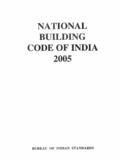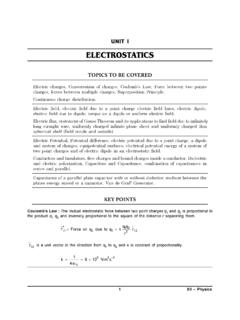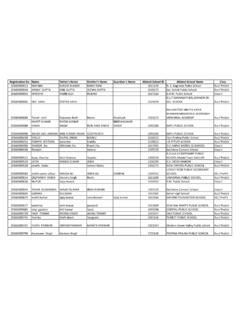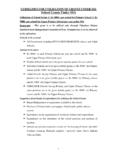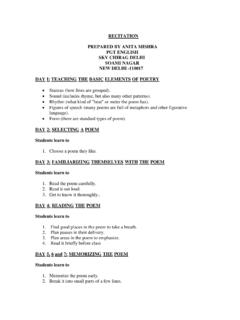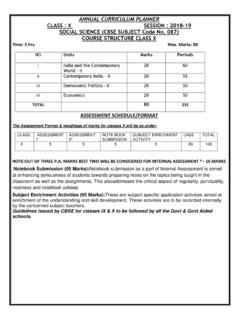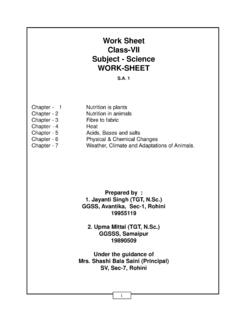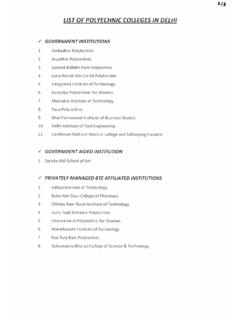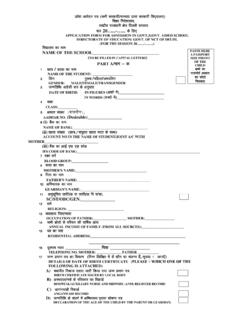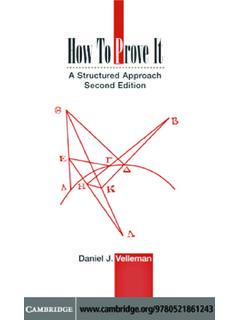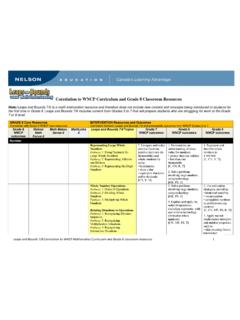Transcription of LIST OF HANDS-ON ACTIVITIES IN MATHEMATICS …
1 1 LIST OFHANDS-ONACTIVITIES IN MATHEMATICSFOR classes III TO VIIIM athematics LaboratoryThe concept of MATHEMATICS Laboratory has been introduced by the Board in itsaffiliated schools with the objective of Making teaching and learning of the subject interactive, participatory, funfillingand joyful from primary stage of schooling. Strengthening the learning of mathematical concepts through concrete materialsand HANDS-ON -experiences. Relating classroom learning to real life situations and discourage rote andmechanical Board has already published detailed guidelines for MathematicalLaboratory in schools for class IX and class X including HANDS-ON ACTIVITIES to bedone during these academic below is the list of ACTIVITIES to be done by the students in classes IIIto VIII during each academic 3 Activity 1:To draw the following on a dot paper (i) a hut (ii) a joker (iii) a flowerActivity 2:To represent the following pair of numbers on straight lines, using stickers.
2 Alsofind the greater number from the representation(i) 7 and 11 (ii) 9 and 5 Activity 3:Group Activity: Body MathematicsDivide the class in groups of 5 students (say)Using a measuring tapeask each group to measure the followingi)Length of the right palmii)Width of the right palmiii)Length of the right eariv)Width of the smileAsk them to note down the following observations:2i)Which group member has longest palm length?ii)Which group member has shortest palm length?iii)Which group member has widest smile?iv)Which group member has longest ear length?v)Which group member has shortest ear length?Activity 4: To measure the dimensions ofdoor or window of room in your houseusing a 1 m long thick thread?Activity 5:a) To count the edges and corners of the following objectsi) Rulerii) Rectangular paperiii) Diceiv) Shoe boxv) Alphabet O b) Fold a rectangular paper from each corner one by one and record the number of edges and corners obtained after every No.
3 Of edges No. of cornersRectangleAfter folding 1st cornerAfter folding 2nd cornerAfter folding 3rd cornerAfter folding 4th corner c) Fold a paper five times in any way. Unfold and draw any shape on thecreases formed. Record the number of edges and corners of the 6 :To make the following shapes using tangram pieces i) a catii) Numeral 4 Activity 7:To make a time scheduler from wake up time to bed time on a working day and a 8:To represent multiplication tables, from 2 to 5, using lines and dots by anactivity method. (Use stickers to represent dots)Activity 9:To identify a number as an even number or an odd number, by making pairs of beads/ 10:To experience money transactions using fake notes and coinsi) Rs. 20 note= four Rs. 5 notes/ coinsii) Rs. 20 note= two Rs. 10 notesiii) Rs. 20 note = ten Rs. 2 coinsiv)Rs. 20 note = twenty Rs. 1 coins4 CLASS4 Activity 1:To draw the following on a dot paperi)triangleii)squareiii)rectangleAct ivity 2:(a)To find the centre of a circle by paper folding and verify thatlength ofradius of the circle is always same.
4 (b)To make a geometrical design using compass and a ruler.(c)To make a pattern of different circles withi) same centre and different radiiii) same radii and centre s on the same lineActivity 3:Do the following by paper foldinga)Transform a square intoi)four rectangular quartersii)four square quartersiii)four triangular quartersb)Transform a rectangle intoi)four rectangular quartersii)four triangular quartersActivity 4:To mark m, m and m on a string of length 1 5:(Hand Print Activity)a)To shade 1/4th region of your palm )To make patterns using thumb 6:To make a repeated tiling pattern on a dot paper , using geometrical shapes as 7:(a)To write a secret code message if all the English alphabets are replaced by numbers from 1 to 26 ,respectively ,in order.(b) To decode the given message on the basis of above 8:(a) To find the length of the boundary of the top of MATHEMATICS text book in (cm) using a thread.
5 (b) To find the length of the boundary of any shape in (cm) drawn on a paper using 9:To write your name using tangram set. Note: Teacher may ask the students to cut tangram pieces using the given diagram. Make duplicate copies of 10:(Group Activity)Divide the class in the groups of 5(say) and perform the followingactivities in each )Measure the height of each member in cm(s) using a measuring )Measurethe weight of each member in (kg) using a weighing machine andanswer the )Who is the tallest member of your group?iv)Who is the shortest member of your group?v)What is the maximum weight measure in your group?vi)What is the minimum weight measure inyour group?6 CLASS 5 Activity 1:To make a set of tangrams by paper folding using 8x8 grid. Using the tangram pieces do the following:a)Try to make a triangle, a square and a rectangle using 2pieces of the tangram )Try to make a triangle, a square and a rectangle using 3pieces of the tangram )Calculate the area of each part by counting completesquares and half 2: (a) To make closed geometrical shapes usingi)3 matchsticksii)4 match sticksiii)5 match sticksiv)6 match sticks (b)To observe the change in angles between any two adjacent match 3: (a)To identify a right angle, angle less than a right angle and angle more thana right angle using body parts and to draw them using stick drawings.
6 (b) Write the word MATHEMATICS using straight lines and observe the numberof right angles, number of angles more than a right angle and number ofangles less than a right angle.(c)To make a degree clockby paper 4:To observe hands of the clock at different time in a day and record fourobservations each of the following(a)right angle between hands of the clock(b)angle less than a right angle between hands of the clock.(c)angle more than a right angle between hands of the 5: (a) To make rectangles of different dimensions on a squared paper using 12 adjacent squares. (b)To calculate the perimeter and area of each of the rectangles so formed. (c)To observe the fact that shapes having same area may have differentperimeter. (d) To observe the relation between dimensions of rectangles and the factors 6:To calculate the perimeter of different shapes formed by shading sixadjacent squares of dimension 1 cm each on a squared paper.
7 Some shapes are shown below8 Activity 7: (a)To represent the fractions , 1/3 , , 1/5, etc. using rectangular strips ofpapers by paper folding. (b)To represent the fractions , , , 3/8 , 5/8 etc. of a circular region bypaper 8:To find the lines of symmetry in the following shapes by paper foldingi)a squareii)a rectangleActivity 9:To make a 3x3 magic square, using numbers from 1 to 9. Hint:Activity 10: (a)To make cube and cuboids of various dimensions using unit cubesi) 2x3x2cubic unitsii) 3x3x2cubic unitsiii) 3x3x3cubic units9 (b)To find the number of missing unit cubes in a given shape to obtain a given shape of desired dimension . Note: Teacher may ask the students to use unit cubes and 6 Activity 1:(a)To verify that addition is commutative for whole numbers, bypaper cutting and pasting.(b)To verify that multiplication is commutative for whole numbers bypaper cutting and 2:To find prime numbers from 1 to 100 by Eratosthenes Sieve 3: (a)to make a cube using the given net and count the number of faces,vertices and 3 (b) To check which of the given nets can be folded to get a 4:To find the HCF of two given numbers by paper cutting 5:To find the LCM of two given numbers by using number 6 (i)Make a line segment of length 5 cm on a paper and do the following bypaper folding.
8 (a)Make a perpendicular line from a point on a given line.(b)Make two intersecting lines.(c)Make two parallel lines. (ii) Do the following by paper folding using a circular cut-out.(a)make a chord(b)make the diameter(c)shade minor and major segment(d)make a sector of a circle. (iii) Represent the following by paperfolding(a)straight angle(b)right angle(c)acute angle(d)obtuse angle(e)reflex angle(iv) Make a protractor by paper 7:To classify the triangles on the basis of sides and angles from the given setof 8:To make the following shapes using a pair of set ) square(ii) rectangle(iii) parallelogram(iv) rhombus(v) trapeziumActivity 9:To represent decimal numbers , , , etc on a 10x10 grid 10:To determine the number of lines of symmetry of following shapes bypaper folding.(a)equilateral triangle(b)isosceles triangle(c)square(d)rectangle(e)rhombus1 3 CLASS- 7 Activity 1:To represent the following products of decimal numbers on a square bydrawing horizontal/ vertical lines and shadingi) x ) x 2:To compare the marks obtained in all the subjects by a student in the firstand second term examination by drawing a bar graph using paper cuttingand :(a) Identify the conditions under which given pair of angles are complimentary.
9 (b) Identify the conditions under which given pair of angles are :To verify that if two lines intersect at a point, then each pair of vertically opposite angles are equal by paper cutting and :To verify that if two parallel lines are cut by a transversal, theni)each pair of corresponding angles are equalii)each pair of alternate interior angles are equaliii)each pair of interior angles on the same side of transversalare supplementary by paper cutting and :(a) To get a median of a triangle from any vertex, by paper folding. To verify that in a triangle, medians pass through a common point, by paper folding.(e)To get an altitude of a triangle from any vertex, by paper folding. To verify that in a triangle altitudes pass through a common point, by paper folding.
10 (Note:- Teacher may take different typesof triangles classified on the basis of sides and angles)Activity7:(a) To verify that the sum of all interior angles of a triangle is 1800by papercutting and pasting.(f)To verify that an exterior angle of a triangle is equal to the sum ofthe two interior opposite angles by paper cutting and :To verify that a triangle can be drawn only if the sum of lengths of anytwo sides is greater than the third side, using broom sticks. Set 1: 5 cm, 7 cm, 11 cm14 Set 2: 5 cm, 7 cm, 14 cmActivity9:To verify Pythagoras theorem using a squared paper by shading the 10: (a)To draw a cube with an edge 5 cm long on an isometric dot paper. Also draw its oblique sketch. (b) To draw a cuboid of dimension 7 cm, 4 cm and 2 cm on an isometric dot paper. Also draw its oblique 8 Activity 1:Fold a paper 8 times in any way.
